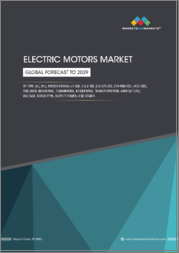
|
시장보고서
상품코드
1660659
전기 모터 시장 보고서 : 모터 유형별, 전압별, 정격 출력별, 자석 유형별, 중량별, 속도별, 용도별, 지역별(2025-2033년)Electric Motor Market Report by Motor Type, Voltage, Rated Power, Magnet Type (Ferrite, Neodymium, Samarium Cobalt ), Weight, Speed, Application, and Region 2025-2033 |
||||||
IMARC Group은 2024년 세계 전기 모터 시장 규모가 1,152억 달러에 달했으며, 2025-2033년간 3.32%의 연평균 성장률(CAGR)을 기록하여 2033년에는 1,570억 달러에 이를 것으로 예측했습니다. 이 시장은 엄격한 배기가스 규제, 신흥국의 급속한 도시화 및 인프라 개발, 전자 분야의 소형화 추세, 제조 공정의 지속적인 기술 발전으로 인한 전기자동차 수요 증가로 인해 꾸준한 성장세를 보이고 있습니다.
전기 모터는 전기 에너지를 기계 에너지로 변환하는 장치로, 전력을 물리적 운동으로 변환할 수 있게 해줍니다. 전류와 자기장의 상호 작용에 의해 기계적 힘이 발생하는 전자기학 원리에 따라 작동합니다. 전기 모터의 주요 부품은 고정자와 회전자로 구성됩니다. 고정자는 고정형이며 일반적으로 코일 또는 권선으로 구성되며 전류가 통과할 때 자기장을 생성합니다. 반면, 로터는 회전하는 부분으로 영구 자석이나 전자석으로 구성되는 경우가 많습니다. 고정자 권선에 전류가 흐르면 자기장이 발생하고, 로터의 자기장과 상호작용하여 로터가 회전합니다.
산업계와 소비자들이 에너지 소비를 줄이고 이산화탄소 배출을 최소화하기 위해 노력하면서 에너지 효율이 높은 솔루션에 대한 수요가 증가하고 있습니다. 전기 모터는 기존 연소 엔진에 비해 효율이 높고 에너지 손실이 적은 것으로 알려져 있습니다. 지속가능성과 에너지 절약의 추구로 전기자동차, 산업기계, 가전제품 등 다양한 분야에서 전기 모터의 채택이 증가하고 있습니다. 또한, 더 깨끗한 운송 수단을 찾는 전 세계적인 움직임으로 인해 전기자동차의 채택이 빠르게 증가하고 있습니다. 전기 모터는 전기자동차의 주요 추진 시스템 역할을 하기 때문에 자동차 부문의 전동화 노력에 있어 중요한 구성 요소로 자리 잡고 있습니다. 이 외에도 생산성과 정확성을 향상시켜야 하는 산업 자동화 추세는 전기 모터에 대한 수요를 증가시키고 있습니다. 모터는 로봇 공학 및 자동 기계에 필수적인 부품으로, 제조 및 물류 공정에서 정밀한 제어와 움직임을 가능하게 합니다. 산업계가 효율성을 높이고 사람의 개입을 줄이려고 노력함에 따라 자동화 분야에서 전기 모터의 판매는 가속화될 것으로 보입니다. 여기에 생산 공정과 규모의 경제가 발전함에 따라 전기 모터의 비용은 기존 대체품에 비해 점점 더 경쟁력이 높아지고 있습니다. 이러한 비용 효율성은 산업용 펌프 및 팬에서 가전제품에 이르기까지 다양한 응용 분야에서 기업과 소비자가 전기 모터로 전환하도록 설득하는 데 도움이 되고 있습니다. 또한, 각국 정부는 전기자동차 및 에너지 효율이 높은 기술의 채택을 촉진하기 위해 엄격한 규제를 시행하고 인센티브를 제공합니다. 이러한 정책은 온실가스 배출을 줄이고 기후 변화에 대응하기 위한 것입니다. 보조금, 세제 혜택, 엄격한 배출 규제는 전기 모터 시장의 성장을 크게 촉진하고 제조업체가 혁신적이고 친환경적인 모터 솔루션을 개발하도록 장려하고 있습니다.
전동기 시장 동향/촉진요인:
에너지 효율에 대한 관심 증가
전기 모터는 기존 내연기관에 비해 효율이 높고 에너지 손실이 적기 때문에 이러한 문제를 해결하는 중요한 구성 요소로 부상하고 있습니다. 전기 모터의 효율은 90%를 초과할 수 있지만, 내연기관 엔진의 효율은 일반적으로 40% 이하입니다. 산업 응용 분야에서는 에너지 효율을 추구하기 위해 펌프, 압축기 및 기타 기계에 전기 모터가 널리 채택되고 있습니다. 에너지 효율이 높은 전기 모터를 사용함으로써 기업은 운영 비용을 낮추고 환경에 미치는 영향을 최소화할 수 있습니다. 또한, 정부 및 규제 기관은 인센티브 및 효율성 표준을 통해 에너지 효율이 높은 모터의 사용을 장려하는 경우가 많습니다.
정부의 이니셔티브와 규제
일부 국가에서는 온실가스 배출량을 줄이고 기후 변화에 대응하기 위한 야심찬 목표를 설정하고, 전기 모터를 포함한 에너지 효율이 높은 기술의 채택을 촉진하는 정책을 시행하고 있습니다. 전기자동차 및 에너지 효율이 높은 가전제품의 생산과 구매를 장려하기 위해 제조업체와 소비자에게 다양한 인센티브 프로그램, 세금 공제 및 보조금을 제공합니다. 이러한 인센티브는 전기 모터에 대한 수요를 자극할 뿐만 아니라 제조업체가 보다 효율적이고 친환경적인 모터 기술을 생산하기 위해 연구개발에 투자할 수 있는 동기를 부여하고 있습니다. 또한, 자동차 제조업체에 대한 배기가스 규제와 규제가 강화되고 있어 전기 모빌리티로의 전환이 요구되고 있습니다. 그 결과, 자동차 제조업체들의 제품 포트폴리오에 전기 모터를 통합하려는 움직임이 활발해지면서 시장을 더욱 견인하고 있습니다.
전기차(EV) 수요 증가
전기모터는 전기자동차의 주요 추진 시스템 역할을 하고 있으며, 전기자동차 보급이 증가함에 따라 그 수요도 급증하고 있습니다. 배터리 기술의 발전으로 에너지 저장량이 향상되고 주행거리가 길어지면서 EV는 더욱 실용적이고 소비자들에게 매력적으로 다가갈 수 있게 되었습니다. 충전 인프라의 이용이 용이해지면서 주행거리 불안에 대한 우려가 더욱 완화되었고, 전기자동차에 대한 소비자의 신뢰가 높아졌습니다. 정부와 정책 입안자들은 재정적 인센티브, 보조금, 규제 지원의 조합을 통해 전기자동차의 채택을 가속화하는 데 매우 중요한 역할을 해왔습니다. 전기자동차가 주류가 되면서 전기자동차에 사용되는 전기모터에 대한 수요는 비약적으로 증가하여 자동차 산업을 변화시키고 전기모터 시장 확대에 큰 기여를 할 것으로 예상됩니다.
목차
제1장 서문
제2장 조사 범위와 조사 방법
- 조사 목적
- 이해관계자
- 데이터 소스
- 1차 정보
- 2차 정보
- 시장 추정
- 보텀업 접근
- 톱다운 접근
- 조사 방법
제3장 주요 요약
제4장 서론
- 개요
- 주요 업계 동향
제5장 세계의 전기 모터 산업
- 시장 개요
- 시장 실적
- COVID-19의 영향
- 시장 분석 : 모터 유형별
- 시장 분석 : 전압별
- 시장 분석 : 정격 출력별
- 시장 분석 : 마그넷 유형별
- 시장 분석 : 지역별
- 시장 분석 : 중량별
- 시장 분석 : 속도별
- 시장 분석 : 용도별
- 시장 예측
제6장 시장 실적 : 모터 유형별
- AC 모터
- 현재와 과거 시장 동향
- 시장 분석 : 유형별
- 유도 교류 모터
- 시장 동향
- 시장 예측
- 동기 교류 모터
- 시장 동향
- 시장 예측
- 유도 교류 모터
- 시장 예측
- DC 모터
- 현재와 과거 시장 동향
- 시장 분석 : 유형별
- 브러쉬 DC 모터
- 시장 동향
- 시장 예측
- 브러쉬리스 DC 모터
- 시장 동향
- 시장 예측
- 브러쉬 DC 모터
- 시장 예측
- 기타
- 현재와 과거 시장 동향
- 시장 예측
제7장 시장 동향 : 전압별
- 저전압 전기 모터
- 중전압 전기 모터
- 고전압 전기 모터
제8장 시장 실적 : 정격 출력별
- 분수 마력 모터
- 적분 마력 모터
제9장 시장 실적 : 분수 마력별
- 분수 마력(최대 1/8) 모터
- 분수 마력(1/8-1/2) 모터
- 분수 마력(1/2-1) 모터
제10장 시장 실적 : 적분 마력 모터별
- 적분 마력(1-5) 모터
- 적분 마력(10-50) 모터
- 적분 마력(50-100) 모터
- 적분 마력(100이상) 모터
제11장 시장 실적 : 자석 유형별
- 페라이트
- 네오디뮴(NdFeB)
- 사마륨 코발트(SmCo5 및 Sm2Co17)
제12장 시장 동향 : 지역별
- 아시아태평양
- 북미
- 유럽
- 중동 및 아프리카
- 라틴아메리카
제13장 시장 실적 : 중량별
- 경량 모터
- 중형 모터
- 고중량 모터
제14장 시장 실적 : 속도별
- 초고속 모터
- 고속 모터
- 중속 모터
- 저속 모터
제15장 시장 실적 : 용도별
- 산업기계
- 공조 설비
- 운송
- 가전제품
- 자동차
- 항공우주
- 해상
- 로봇 공학
- 기타
제16장 경쟁 구도
- 시장 구조
- 시장 분석 : 주요 기업별
제17장 주요 기업 개요
- ABB Group
- Siemens Ag
- WEG SA
- TECO
- Nidec Corporation
- Regal Beloit Corporation
The global electric motor market size reached USD 115.2 Billion in 2024. Looking forward, IMARC Group expects the market to reach USD 157.0 Billion by 2033, exhibiting a growth rate (CAGR) of 3.32% during 2025-2033. The market is experiencing steady growth driven by the growing demand for electric vehicles supported by stringent emission regulations, rapid urbanization and infrastructure development in emerging economies, rising trend of the miniaturization in the field of electronics, and continual technological advancements in manufacturing processes.
An electric motor is a device that converts electrical energy into mechanical energy, enabling the conversion of electrical power into physical motion. It operates on the principle of electromagnetism, where the interaction between electric currents and magnetic fields results in the generation of mechanical force. The key components of an electric motor include a stator and a rotor. The stator is the stationary part, typically made up of coils or windings, which produce a magnetic field when an electric current passes through them. The rotor, on the other hand, is the rotating part, often composed of permanent magnets or electromagnets. When an electric current flows through the stator windings, it creates a magnetic field that interacts with the magnetic field of the rotor, causing the rotor to spin.
As industries and consumers seek to reduce energy consumption and minimize their carbon footprint, there is a growing demand for energy-efficient solutions. Electric motors, compared to traditional combustion engines, are known for their higher efficiency and lower energy losses. The pursuit of sustainability and energy conservation has led to a rise in the adoption of electric motors in various applications, including electric vehicles, industrial machinery, and home appliances. Additionally, the global push for cleaner transportation alternatives has led to a rapid increase in the adoption of electric vehicles. Electric motors serve as the primary propulsion system in EVs, making them a critical component in the automotive sector's electrification efforts. Other than this, the ongoing industrial automation trend, driven by the need for increased productivity and precision, has escalated the demand for electric motors. Motors are essential components in robotics and automated machinery, enabling precise control and motion in manufacturing and logistics processes. As industries seek to enhance efficiency and reduce human intervention, the sales of electric motors in automation is set to accelerate. Besides this, with advancements in production processes and economies of scale, the cost of electric motors has become increasingly competitive compared to traditional alternatives. This cost-effectiveness has been instrumental in convincing businesses and consumers to shift towards electric motors in different applications, from industrial pumps and fans to household appliances. Moreover, governments worldwide are implementing stringent regulations and providing incentives to promote the adoption of electric vehicles and energy-efficient technologies. These policies aim to reduce greenhouse gas emissions and combat climate change. Subsidies, tax benefits, and stricter emission norms have significantly boosted the electric motor market's growth and encouraged manufacturers to develop innovative and eco-friendly motor solutions.
Electric Motor Market Trends/Drivers:
Increasing Emphasis on Energy Efficiency
Electric motors have emerged as a crucial component in addressing these concerns due to their higher efficiency and reduced energy losses compared to conventional combustion engines. The efficiency of an electric motor can exceed 90%, while internal combustion engines typically have efficiencies below 40%. In industrial applications, the drive for energy efficiency has led to the widespread adoption of electric motors in pumps, compressors, and other machinery. By using energy-efficient electric motors, businesses can lower their operational costs and minimize their environmental impact. Moreover, governments and regulatory bodies often encourage the use of energy-efficient motors through incentives and efficiency standards.
Government Initiatives and Regulations
Several countries have set ambitious goals to reduce greenhouse gas emissions and combat climate change, prompting the implementation of policies that promote the adoption of energy-efficient technologies, including electric motors. Various incentive programs, tax credits, and subsidies are offered to manufacturers and consumers to encourage the production and purchase of electric vehicles and energy-efficient appliances. These incentives not only create a demand pull for electric motors but also incentivize manufacturers to invest in research and development to produce more efficient and environmentally friendly motor technologies. Furthermore, emission norms and regulations on vehicle manufacturers have become more stringent, necessitating a shift towards electric mobility. As a result, automotive manufacturers are increasingly incorporating electric motors into their product portfolios, further driving the market.
Rising Demand for Electric Vehicles (EVs)
Electric motors serve as the primary propulsion system in EVs, and the demand for these motors has soared in tandem with the rise in electric vehicle adoption. Advancements in battery technology, resulting in improved energy storage and longer driving ranges, have made EVs more practical and appealing to consumers. The increased availability of charging infrastructure has further allayed concerns about range anxiety, boosting consumer confidence in electric vehicles. Governments and policymakers have played a pivotal role in accelerating the adoption of electric vehicles through a combination of financial incentives, subsidies, and regulatory support. As electric vehicles become more mainstream, the demand for electric motors used in EVs is expected to witness exponential growth, transforming the automotive industry and contributing significantly to the expansion of the electric motor market.
Electric Motor Industry Segmentation:
Breakup by Motor Type:
- AC Motor
- Induction AC Motor
- Synchronous AC Motor
- DC Motor
- Brushed DC Motor
- Brushless DC Motor
- Others
AC motors dominate the market
Breakup by Voltage:
- Low Voltage Electric Motors
- Medium Voltage Electric Motors
- High Voltage Electric Motors
Low voltage electric motors hold the largest share in the market
Breakup by Rated Power:
- Fractional Horsepower Motors
- Fractional Horsepower (< 1/8) Motors
- Fractional Horsepower (1/8 - 1/2) Motors
- Fractional Horsepower (1/2 - 1) Motors
- Integral Horsepower Motors
- Integral Horsepower (1 - 5) Motors
- Integral Horsepower (10 - 50) Motors
- Integral Horsepower (50 - 100) Motors
- Integral Horsepower (>100) Motors
Fractional horsepower dominates the market
Breakup by Magnet Type:
- Ferrite
- Neodymium (NdFeB)
- Samarium Cobalt (SmCo5 and Sm2Co17)
Ferrite holds the largest share in the market
Breakup by Weight:
- Low Weight Motors
- Medium Weight Motors
- High Weight Motors
Low weight motors account for the majority of market share
Breakup by Speed:
- Ultra-High-Speed Motors
- High-Speed Motors
- Medium Speed Motors
- Low Speed Motors
High-speed motors hold the largest share in the market
Breakup by Application:
- Industrial Machinery
- HVAC
- Transportation
- Household Appliances
- Motor Vehicles
- Aerospace
- Marine
- Robotics
- Others
Industrial machinery represent the largest application segment
Breakup by Region:
- Asia-Pacific
- North America
- Europe
- Middle East and Africa
- Latin America
Asia Pacific exhibits a clear dominance in the market
The report has also provided a comprehensive analysis of all the major regional markets, which include Asia Pacific, North America, Europe, Middle East and Africa, Latin America. According to the report, Asia Pacific was the largest market for electric motors.
The report has provided a comprehensive analysis of the competitive landscape in the market. Detailed profiles of all major companies have also been provided. Some of the key players in the market include:
- ABB Group
- Siemens AG
- WEG SA
- TECO
- Regal Beloit Corporation
- Nidec Corporation
Key Questions Answered in This Report
- 1.What was the size of the global electric motor market in 2024?
- 2.What is the expected growth rate of the global electric motor market during 2025-2033?
- 3.What are the key factors driving the global electric motor market?
- 4.What has been the impact of COVID-19 on the global electric motor market?
- 5.What is the breakup of the global electric motor market based on the motor type?
- 6.What is the breakup of the global electric motor market based on the voltage?
- 7.What is the breakup of the global electric motor market based on the rated power?
- 8.What is the breakup of the global electric motor market based on the magnet type?
- 9.What is the breakup of the global electric motor market based on the weight?
- 10.What is the breakup of the global electric motor market based on the speed?
- 11.What is the breakup of the global electric motor market based on the application?
- 12.What are the key regions in the global electric motor market?
- 13.Who are the key players/companies in the global electric motor market?
Table of Contents
1 Preface
2 Scope and Methodology
- 2.1 Objectives of the Study
- 2.2 Stakeholders
- 2.3 Data Sources
- 2.3.1 Primary Sources
- 2.3.2 Secondary Sources
- 2.4 Market Estimation
- 2.4.1 Bottom-Up Approach
- 2.4.2 Top-Down Approach
- 2.5 Forecasting Methodology
3 Executive Summary
4 Introduction
- 4.1 Overview
- 4.2 Key Industry Trends
5 Global Electric Motor Industry
- 5.1 Market Overview
- 5.2 Market Performance
- 5.3 Impact of COVID-19
- 5.4 Market Breakup by Motor Type
- 5.5 Market Breakup by Voltage
- 5.6 Market Breakup by Rated Power
- 5.7 Market Breakup by Magnet Type
- 5.8 Market Breakup by Region
- 5.9 Market Breakup by Weight
- 5.10 Market Breakup by Speed
- 5.11 Market Breakup by Application
- 5.12 Market Forecast
6 Market Performance by Motor Type
- 6.1 AC Motor
- 6.1.1 Current and Historical Market Trends
- 6.1.2 Market Breakup by Type
- 6.1.2.1 Induction AC Motor
- 6.1.2.1.1 Market Trends
- 6.1.2.1.2 Market Forecast
- 6.1.2.2 Synchronous AC Motor
- 6.1.2.2.1 Market Trends
- 6.1.2.2.2 Market Forecast
- 6.1.2.1 Induction AC Motor
- 6.1.3 Market Forecast
- 6.2 DC Motor
- 6.2.1 Current and Historical Market Trends
- 6.2.2 Market Breakup by Type
- 6.2.2.1 Brushed DC Motor
- 6.2.2.1.1 Market Trends
- 6.2.2.1.2 Market Forecast
- 6.2.2.2 Brushless DC Motor
- 6.2.2.2.1 Market Trends
- 6.2.2.2.2 Market Forecast
- 6.2.2.1 Brushed DC Motor
- 6.2.3 Market Forecast
- 6.3 Others
- 6.3.1 Current and Historical Market Trends
- 6.3.2 Market Forecast
7 Market Performance by Voltage
- 7.1 Low Voltage Electric Motors
- 7.1.1 Current and Historical Market Trends
- 7.1.2 Market Forecast
- 7.2 Medium Voltage Electric Motors
- 7.2.1 Current and Historical Market Trends
- 7.2.2 Market Forecast
- 7.3 High Voltage Electric Motors
- 7.3.1 Current and Historical Market Trends
- 7.3.2 Market Forecast
8 Market Performance by Rated Power
- 8.1 Fractional Horsepower Motors
- 8.1.1 Current and Historical Market Trends
- 8.1.2 Market Forecast
- 8.2 Integral Horsepower Motors
- 8.2.1 Current and Historical Market Trends
- 8.2.2 Market Forecast
9 Market Performance by Fractional Horsepower
- 9.1 Fractional Horsepower (< 1/8) Motors
- 9.1.1 Current and Historical Market Trends
- 9.1.2 Market Forecast
- 9.2 Fractional Horsepower (1/8 - 1/2) Motors
- 9.2.1 Current and Historical Market Trends
- 9.2.2 Market Forecast
- 9.3 Fractional Horsepower (1/2 - 1) Motors
- 9.3.1 Current and Historical Market Trends
- 9.3.2 Market Forecast
10 Market Performance by Integral Horsepower
- 10.1 Integral Horsepower (1 - 5) Motors
- 10.1.1 Current and Historical Market Trends
- 10.1.2 Market Forecast
- 10.2 Integral Horsepower (10 - 50) Motors
- 10.2.1 Current and Historical Market Trends
- 10.2.2 Market Forecast
- 10.3 Integral Horsepower (50 - 100) Motors
- 10.3.1 Current and Historical Market Trends
- 10.3.2 Market Forecast
- 10.4 Integral Horsepower (>100) Motors
- 10.4.1 Current and Historical Market Trends
- 10.4.2 Market Forecast
11 Market Performance by Magnet Type
- 11.1 Ferrite
- 11.2 Neodymium (NdFeB)
- 11.3 Samarium Cobalt (SmCo5 and Sm2Co17)
12 Market Performance by Region
- 12.1 Asia-Pacific
- 12.1.1 Current and Historical Market Trends
- 12.1.2 Market Forecast
- 12.2 North America
- 12.2.1 Current and Historical Market Trends
- 12.2.2 Market Forecast
- 12.3 Europe
- 12.3.1 Current and Historical Market Trends
- 12.3.2 Market Forecast
- 12.4 Middle East and Africa
- 12.4.1 Current and Historical Market Trends
- 12.4.2 Market Forecast
- 12.5 Latin America
- 12.5.1 Current and Historical Market Trends
- 12.5.2 Market Forecast
13 Market Performance by Weight
- 13.1 Low Weight Motors
- 13.1.1 Current and Historical Market Trends
- 13.1.2 Market Forecast
- 13.2 Medium Weight Motors
- 13.2.1 Current and Historical Market Trends
- 13.2.2 Market Forecast
- 13.3 High Weight Motors
- 13.3.1 Current and Historical Market Trends
- 13.3.2 Market Forecast
14 Market Performance by Speed
- 14.1 Ultra-High-Speed Motors
- 14.1.1 Current and Historical Market Trends
- 14.1.2 Market Forecast
- 14.2 High-Speed Motors
- 14.2.1 Current and Historical Market Trends
- 14.2.2 Market Forecast
- 14.3 Medium Speed Motors
- 14.3.1 Current and Historical Market Trends
- 14.3.2 Market Forecast
- 14.4 Low Speed Motors
- 14.4.1 Current and Historical Market Trends
- 14.4.2 Market Forecast
15 Market Performance by Application
- 15.1 Industrial Machinery
- 15.1.1 Current and Historical Market Trends
- 15.1.2 Market Forecast
- 15.2 HVAC
- 15.2.1 Current and Historical Market Trends
- 15.2.2 Market Forecast
- 15.3 Transportation
- 15.3.1 Current and Historical Market Trends
- 15.3.2 Market Forecast
- 15.4 Household Appliances
- 15.4.1 Current and Historical Market Trends
- 15.4.2 Market Forecast
- 15.5 Motor Vehicles
- 15.5.1 Current and Historical Market Trends
- 15.5.2 Market Forecast
- 15.6 Aerospace
- 15.6.1 Current and Historical Market Trends
- 15.6.2 Market Forecast
- 15.7 Marine
- 15.7.1 Current and Historical Market Trends
- 15.7.2 Market Forecast
- 15.8 Robotics
- 15.8.1 Current and Historical Market Trends
- 15.8.2 Market Forecast
- 15.9 Others
- 15.9.1 Current and Historical Market Trends
- 15.9.2 Market Forecast
16 Competitive Landscape
- 16.1 Market Structure
- 16.2 Market Breakup by Key Players
17 Key Players Profiles
- 17.1 ABB Group
- 17.1.1 Company Overview
- 17.1.2 Company Description
- 17.1.3 Product Portfolio
- 17.1.4 Financials
- 17.1.5 Key Contacts
- 17.2 Siemens Ag
- 17.2.1 Company Overview
- 17.2.2 Company Description
- 17.2.3 Operations
- 17.2.4 Product Portfolio
- 17.2.5 Geographic Reach
- 17.2.6 Sales and Marketing
- 17.2.7 Strategy
- 17.2.8 Mergers and Acquisitions
- 17.2.9 SWOT Analysis
- 17.2.10 Financials
- 17.2.11 Key Contacts
- 17.3 WEG SA
- 17.3.1 Company Overview
- 17.3.2 Company Description
- 17.3.3 Product Portfolio
- 17.3.4 Financials
- 17.3.5 Key Contacts
- 17.4 TECO
- 17.4.1 Company Overview
- 17.4.2 Company Description
- 17.4.3 Product Portfolio
- 17.4.4 Financials
- 17.4.5 Key Contacts
- 17.5 Regal Beloit Corporation
- 17.5.1 Company Overview
- 17.5.2 Company Description
- 17.5.3 Product Portfolio
- 17.5.4 Operations
- 17.5.5 Geographic Reach
- 17.5.6 Sales and Marketing
- 17.5.7 Strategy
- 17.5.8 Mergers and Acquisitions
- 17.5.9 Financials
- 17.5.10 Key Contacts
- 17.6 Nidec Corporation
- 17.6.1 Company Overview
- 17.6.2 Company Description
- 17.6.3 Product Portfolio
- 17.6.4 Geographic Reach
- 17.6.5 Strategy
- 17.6.6 SWOT Analysis
- 17.6.7 Financials
- 17.6.8 Key Contacts



















